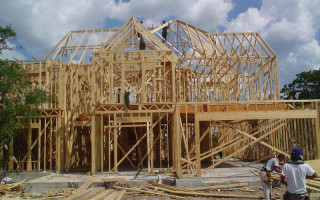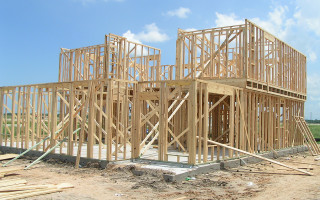For More Information Call (219) 712-9739
New Home Framing
Project: House Framing
Location: Aberdeen, Indiana
Contractor: Jeff Jones
Framing, in construction is the fitting together of pieces to give a structure support and shape and sometimes is used as a noun such as "the framing" or "framing members". Framing materials are usually wood, engineered wood, or structural steel. Building framing is divided into two broad categories, heavy-frame construction (heavy framing) if the vertical supports are few and heavy such as in timber framing, pole building framing, or steel framing or many and smaller called light-frame construction (light framing) including balloon, platform and light-steel framing. Light-frame construction using standardized dimensional lumber has become the dominant construction method in North America and Australia because of its economy. Use of minimal structural material allows builders to enclose a large area with minimal cost, while achieving a wide variety of architectural styles. Historically mankind fitted naturally shaped wooden poles together as framework and then began using joints to connect the timbers, a method today called traditional timber framing. Timber framing was superseded by balloon framing beginning in the 1830s in America which is made up of many light-weight wall members called studs rather than using fewer, heavier supports called posts, and was nailed together rather than using joinery. The studs in a balloon frame extend two stories from sill to plate. Platform framing superseded balloon framing and is the standard wooden framing method today. The name comes from each floor level being framed as a separate unit or platform.
Modern light-frame structures usually gain strength from rigid panels (plywood and other plywood-like composites such as oriented strand board (OSB) used to form all or part of wall sections) but until recently carpenters employed various forms of diagonal bracing to stabilize walls. Diagonal bracing remains a vital interior part of many roof systems, and in-wall wind braces are required by building codes in many municipalities or by individual state laws in the United States. Special framed shear walls are becoming more common to help buildings meet the requirements of earthquake engineering and wind engineering.
© 2015 - Ashford Builders & Roofing. All Rights Reserved.








